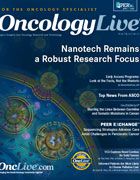Early Access Programs: Look at the Facts, Not the Rhetoric
The impact of the Trump administration's agenda is being felt in the healthcare arena, prominently in the oversight for drug approvals.
Maurie Markman, MD
The Trump administration has made clear in public statements and leadership appointments its dislike for what it calls excessive federal regulations. The impact of the administration’s agenda is being felt in the healthcare arena, prominently in the oversight for drug approvals. A component of this discussion highly relevant to oncology has been the debate over granting patients earlier access to novel antineoplastic agents outside the realm of carefully regulated clinical investigative efforts.
Not surprisingly, the current administration’s perspective and that of a substantial number of state governments is not universally shared and there has been a stream of commentary from recognized or self-declared experts appearing in the lay and scientific press regarding a perceived lack of wisdom associated with the implementation of suggested policies.
Such discussions are appropriate and potentially quite helpful as we move forward as a society to more effectively deal with the increasing mismatch between existing and often quite entrenched interpretations of decades-old drug regulatory mandates and the stunningly brisk changes in our understanding of the molecular bases of health and disease which are leading to the rapid introduction of exciting novel therapeutics.
Unfortunately, this debate contains a concerning element of invalid or highly questionable statements by individuals whose credentials suggest they should know better.
Consider, for example, a recent commentary in The Wall Street Journal by a former FDA official about the intense debate surrounding state-based “right-to-try laws.”1 Although this individual has a medical and an advanced science degree, the commentator remarkably declares:
“Phase I testing, often the first time a new drug has been administered to humans, provides extremely limited information. These trials are performed on between 20 and 200 patients and last only a short time. They’re usually administered to paid, healthy volunteers, who may not provide good representation of how the drug will affect terminal patients. Such trials essentially exist to determine what doses of the drug are tolerated without causing gross safety problems such as seizures, organ failure, or death.”1 It is important to remember that in the sphere of oncology, the specific intent of “right-to-try laws” is to provide the opportunity for patients in life-threatening situations to receive a novel drug strategy. And it is equally important to remember the many advances that have flowed from earlyphase testing.
For example, there are the 53 of 54 patients with chronic myeloid leukemia who entered the first phase I trial of imatinib, received at least 300 mg of the agent daily, and subsequently achieved sustained complete hematologic responses.2 More than a decade ago, researchers reported in a high-impact peer-reviewed journal that National Cancer Institute-sponsored phase I clinical trials with an FDA-approved agent in addition to an experimental drug resulted in almost 1 in 5 patients achieving an objective response.3
Similarly, investigators from an internationally recognized major cancer center published a provocative nonrandomized experience revealing an improvement in the objective response rate (27% vs 5%; P <.0001) and overall survival (median 13.4 vs 9.0 months; P = .017) in phase I studies with solid preclinical data indicating that the study agent could effectively target a driver molecular abnormality compared with phase I trial participants who did not receive a precision medicine-based strategy.4
These examples suggest that this editorialist, despite his impressive credentials, is the one who is getting it wrong. Unfortunately, clinical science as a discipline and clinical scientists as a group will be held accountable when the public understands the distressing lack of objectivity articulated by some participants in this complex debate.
Finally, consider a second example of such rhetoric, this time published in a high-impact scientific journal, discussing the need (in the opinion of the commentators) for essentially unchanged requirements associated with the drug regulatory approval process.5 This commentary states:
“Rigorous clinical studies are still the best way to learn whether a drug works, and regulation is essential to ensure that these studies are conducted. Prespecified endpoints, controls, randomization, and blinding cannot be discarded without sacrificing actionable clinical information.”5
Notwithstanding the ever-increasing evidence for the disturbing lack of clinical relevance of randomized trials to real-world patients with cancer (eg, older individuals with comorbidities seriously underrepresented in clinical trials), what would one say to the 1% of patients with non— small lung cancer whose malignancies have a ROS1 rearrangement? Crizotinib, a targeted antineoplastic, has been shown in a nonrandomized expanded phase I trial to produce a 72% response rate with a median duration of response of 17.6 months.6
Should such a highly effective therapy not be considered the standard of care until a study with randomization and blinding has been completed and favorable results reported? Perhaps it should not come as a surprise when we learn that many in the public appear to be losing confidence in the academic medical establishment or at least in their self-declared spokespersons.
References
- Miller HI. On ‘right to try,’ the FDA should proceed with caution. Wall Street Journal. March 14, 2017. www.wsj.com/articles/onright- to-try-the-fda-should-proceed-with-caution-1489445804. Accessed June 22, 2017.
- Druker BJ, Talpaz M, Resta DJ, et al. Efficacy and safety of a specific inhibitor of the BCR-ABL tyrosine kinase in chronic myeloid leukemia. N Engl J Med. 2001;344(14):1031-1037. doi: 10.1056/ NEJM200104053441401.
- Horstmann E, McCabe MS, Grochow L, et al. Risks and benefits of phase 1 oncology trials, 1991 through 2002. N Engl J Med. 2005;352(9):895-904. doi: 10.1056/NEJMsa042220.
- Tsimberidou A-M, Iskander NG, Hong DS, et al. Personalized medicine in a phase I clinical trials program: the MD Anderson Cancer Center initiative. Clin Cancer Res. 2012;18(22):6373-6383. doi: 10.1158/1078-0432.CCR-12-1627.
- Sipp D, McCabe C, Rasko JEJ. Show drugs work before selling them. Nature. 2017;543(7644):174-175. doi: 10.1038/543174a.
- Shaw AT, Ou SH, Bang YJ, et al. Crizotinib in ROS1-rearranged non-small-cell lung cancer. N Engl J Med. 2014;371(21):1963- 1971. doi: 10.1056/NEJMoa1406766.




